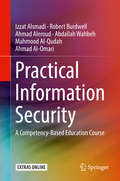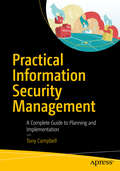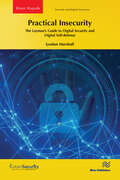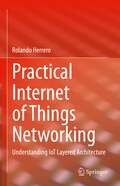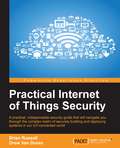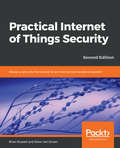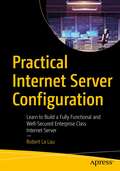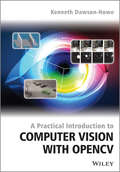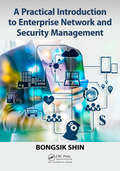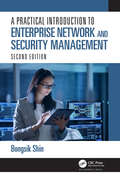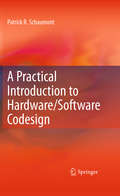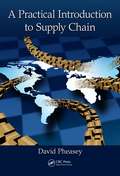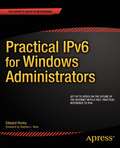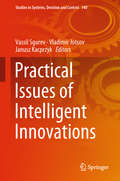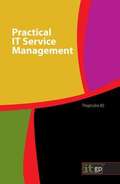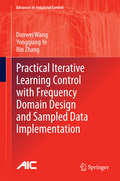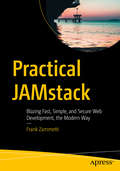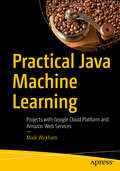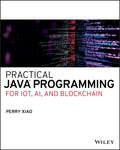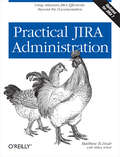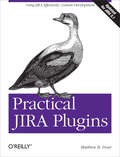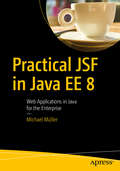- Table View
- List View
Practical Information Security: A Competency-based Education Course
by Ahmed Aleroud Izzat Alsmadi Robert Burdwell Abdallah Wahbeh Mahmoud Ali Al-Qudah Ahmad Al-OmariThis textbook presents a practical introduction to information security using the Competency Based Education (CBE) method of teaching. The content and ancillary assessment methods explicitly measure student progress in the three core categories: Knowledge, Skills, and Experience, giving students a balance between background knowledge, context, and skills they can put to work. Students will learn both the foundations and applications of information systems security; safeguarding from malicious attacks, threats, and vulnerabilities; auditing, testing, and monitoring; risk, response, and recovery; networks and telecommunications security; source code security; information security standards; and compliance laws. The book can be used in introductory courses in security (information, cyber, network or computer security), including classes that don't specifically use the CBE method, as instructors can adjust methods and ancillaries based on their own preferences. The book content is also aligned with the Cybersecurity Competency Model, proposed by department of homeland security. The author is an active member of The National Initiative for Cybersecurity Education (NICE), which is led by the National Institute of Standards and Technology (NIST). NICE is a partnership between government, academia, and the private sector focused on cybersecurity education, training, and workforce development.
Practical Information Security Management
by Tony CampbellCreate appropriate, security-focused business propositions that consider the balance between cost, risk, and usability, while starting your journey to become an information security manager. Covering a wealth of information that explains exactly how the industry works today, this book focuses on how you can set up an effective information security practice, hire the right people, and strike the best balance between security controls, costs, and risks. Practical Information Security Management provides a wealth of practical advice for anyone responsible for information security management in the workplace, focusing on the 'how' rather than the 'what'. Together we'll cut through the policies, regulations, and standards to expose the real inner workings of what makes a security management program effective, covering the full gamut of subject matter pertaining to security management: organizational structures, security architectures, technical controls, governance frameworks, and operational security. This book was not written to help you pass your CISSP, CISM, or CISMP or become a PCI-DSS auditor. It won't help you build an ISO 27001 or COBIT-compliant security management system, and it won't help you become an ethical hacker or digital forensics investigator - there are many excellent books on the market that cover these subjects in detail. Instead, this is a practical book that offers years of real-world experience in helping you focus on the getting the job done. What You Will Learn Learn the practical aspects of being an effective information security manager Strike the right balance between cost and risk Take security policies and standards and make them work in reality Leverage complex security functions, such as Digital Forensics, Incident Response and Security Architecture Who This Book Is For Anyone who wants to make a difference in offering effective security management for their business. You might already be a security manager seeking insight into areas of the job that you've not looked at before, or you might be a techie or risk guy wanting to switch into this challenging new career. Whatever your career goals are, Practical Security Management has something to offer you.
Practical Insecurity: The Layman's Guide to Digital Security and Digital Self-defense (River Publishers Series in Rapids in Security and Digital Forensics)
by Lyndon MarshallThis book provides practical advice for everyone on how to effectively secure yourself, your devices, and your privacy in an era where all of those things seem doomed. From acquiring software, to the ongoing flaws in email, to the risks of file sharing, and issues surrounding social media and social reputation, Practical Insecurity is the tool you need to maximize your self-protection in the digital world. Everyone has had a brush with cybersecurity—in some way. Our computer has gotten a virus, somebody you know has lost all their company’s data because of ransomware, someone has stolen our identity, a store we do business with has their computer system compromised—including our account—so we are offered free identity protection, and so on. It seems like everyday there is another bit of bad news and it often impacts us. But, the question largely goes unanswered: what can I do as an individual or as the owner of a small business to protect myself against having my security compromised? Practical Insecurity provides the answers.
Practical Internet of Things Networking: Understanding IoT Layered Architecture
by Rolando HerreroThis textbook explores the different protocols and technologies that are key to supporting the most important Internet of Things (IoT) networking scenarios. Intended for upper undergraduate classes, the author presents these protocols and technologies from a perspective of the standard layered architecture with special focus on protocol interaction and functionality. To this end, the book provides a unique step-by-step hands-on approach that enables the reader to use common software tools and network emulators to understand, prototype, and deploy a vast range of use cases. The author shows how these topologies, which rely on standard physical layer technologies like LoRa, NB-IoT, LTE-M, IEEE 802.15.4 and BLE, provide end-to-end IPv6 connectivity and comply with the most important requirements of industrial IoT solutions. The book helps readers learn how to build IoT networks through exercises, lab projects, and examples.
Practical Internet of Things Security
by Drew Van Duren Brian RussellA practical, indispensable security guide that will navigate you through the complex realm of securely building and deploying systems in our IoT-connected world About This Book * Learn to design and implement cyber security strategies for your organization * Learn to protect cyber-physical systems and utilize forensic data analysis to beat vulnerabilities in your IoT ecosystem * Learn best practices to secure your data from device to the cloud * Gain insight into privacy-enhancing techniques and technologies Who This Book Is For This book targets IT Security Professionals and Security Engineers (including pentesters, security architects and ethical hackers) who would like to ensure security of their organization's data when connected through the IoT. Business analysts and managers will also find it useful. What You Will Learn * Learn how to break down cross-industry barriers by adopting the best practices for IoT deployments * Build a rock-solid security program for IoT that is cost-effective and easy to maintain * Demystify complex topics such as cryptography, privacy, and penetration testing to improve your security posture * See how the selection of individual components can affect the security posture of the entire system * Use Systems Security Engineering and Privacy-by-design principles to design a secure IoT ecosystem * Get to know how to leverage the burdgening cloud-based systems that will support the IoT into the future. In Detail With the advent of Intenret of Things (IoT), businesses will be faced with defending against new types of threats. The business ecosystem now includes cloud computing infrastructure, mobile and fixed endpoints that open up new attack surfaces, a desire to share information with many stakeholders and a need to take action quickly based on large quantities of collected data. . It therefore becomes critical to ensure that cyber security threats are contained to a minimum when implementing new IoT services and solutions. . The interconnectivity of people, devices, and companies raises stakes to a new level as computing and action become even more mobile, everything becomes connected to the cloud, and infrastructure is strained to securely manage the billions of devices that will connect us all to the IoT. This book shows you how to implement cyber-security solutions, IoT design best practices and risk mitigation methodologies to address device and infrastructure threats to IoT solutions. This book will take readers on a journey that begins with understanding the IoT and how it can be applied in various industries, goes on to describe the security challenges associated with the IoT, and then provides a set of guidelines to architect and deploy a secure IoT in your Enterprise. The book will showcase how the IoT is implemented in early-adopting industries and describe how lessons can be learned and shared across diverse industries to support a secure IoT. Style and approach This book aims to educate readers on key areas in IoT security. It walks readers through engaging with security challenges and then provides answers on how to successfully manage IoT security and build a safe infrastructure for smart devices. After reading this book, you will understand the true potential of tools and solutions in order to build real-time security intelligence on IoT networks.
Practical Internet of Things Security: Design a security framework for an Internet connected ecosystem, 2nd Edition
by Brian Russell Drew Van DurenA practical, indispensable security guide that will navigate you through the complex realm of securely building and deploying systems in our IoT-connected worldKey FeaturesLearn best practices to secure your data from the device to the cloudUse systems security engineering and privacy-by-design principles to design a secure IoT ecosystemA practical guide that will help you design and implement cyber security strategies for your organizationBook DescriptionWith the advent of the Internet of Things (IoT), businesses have to defend against new types of threat. The business ecosystem now includes the cloud computing infrastructure, mobile and fixed endpoints that open up new attack surfaces. It therefore becomes critical to ensure that cybersecurity threats are contained to a minimum when implementing new IoT services and solutions.This book shows you how to implement cybersecurity solutions, IoT design best practices, and risk mitigation methodologies to address device and infrastructure threats to IoT solutions.In this second edition, you will go through some typical and unique vulnerabilities seen within various layers of the IoT technology stack and also learn new ways in which IT and physical threats interact. You will then explore the different engineering approaches a developer/manufacturer might take to securely design and deploy IoT devices. Furthermore, you will securely develop your own custom additions for an enterprise IoT implementation. You will also be provided with actionable guidance through setting up a cryptographic infrastructure for your IoT implementations. You will then be guided on the selection and configuration of Identity and Access Management solutions for an IoT implementation. In conclusion, you will explore cloud security architectures and security best practices for operating and managing cross-organizational, multi-domain IoT deployments.What you will learnDiscuss the need for separate security requirements and apply security engineering principles on IoT devicesMaster the operational aspects of planning, deploying, managing, monitoring, and detecting the remediation and disposal of IoT systemsUse Blockchain solutions for IoT authenticity and integrityExplore additional privacy features emerging in the IoT industry, such as anonymity, tracking issues, and countermeasuresDesign a fog computing architecture to support IoT edge analyticsDetect and respond to IoT security incidents and compromisesWho this book is forThis book targets IT Security Professionals and Security Engineers (including pentesters, security architects and ethical hackers) who would like to ensure the security of their organization's data when connected through the IoT. Business analysts and managers will also find this book useful.
Practical Internet of Things with JavaScript (ES5/ES6): Build standalone exciting IoT projects with Raspberry Pi 3 and JavaScript (ES5/ES6)
by Arvind Ravulavaru Vijaya Kumar SudaKey Features Leverage the capability of IoT with the combination of Raspberry Pi 3 and JavaScript (ES5/ES6) Develop a health monitoring device along with some cool projects like Smart Agriculture & Raspberry Pi 3 based surveillance. A practical book which will help you build Mobile/Web/Desktop apps that will show how to manage and monitor data from sensors and actuators in real time. Book Description In this world of technology upgrades, IoT is currently leading with its promise to make the world a more smarter and efficient place. This book will show you how to build simple IoT solutions that will help you to understand how this technology works. We would not only explore the IoT solution stack, but we will also see how to do it with the world’s most misunderstood programming language - JavaScript. Using Raspberry Pi 3 and JavaScript (ES5/ES6) as the base to build all the projects, you will begin with learning about the fundamentals of IoT and then build a standard framework for developing all the applications covered in this book. You will then move on to build a weather station with temperature, humidity and moisture sensors and further integrate Alexa with it. Further, you will build a smart wearable for understanding the concept of fall detection. You will then extend it with the 'If This Then That' (IFTTT) rules engine to send an email on fall detection. Finally, you will be working with the Raspberry Pi 3 camera module and surveillance with a bit of facial detection using Amazon Rekognition platform. At the end of the book, you will not only be able to build standalone exciting IoT applications but also learn how you can extend your projects to another level. What you will learn Integrate sensors and actuators with the cloud and control them for your Smart Weather Station. Develop your very own Amazon Alexa integrating with your IoT solution Define custom rules and execute jobs on certain data events using IFTTT Build a simple surveillance solutions using Amazon Recognition & Raspberry Pi 3 Design a fall detection system and build a notification system for it. Use Amazon Rekognition for face detection and face recognition in your Surveillance project
Practical Internet Server Configuration: Learn to Build a Fully Functional and Well-Secured Enterprise Class Internet Server
by Robert La LauLearn the skills to complete the full installation, configuration, and maintenance of an enterprise class internet server, no matter what Unix-like operating system you prefer. This book will rapidly guide you towards real system administration, with clear explanations along the way.After a chapter explaining the most important Unix basics, you will start with a vanilla server as delivered by a hosting provider and by the end of the book, you will have a fully functional and well-secured enterprise class internet server. You will also be equipped with the expertise needed to keep your server secured and up to date. All configuration examples are given for FreeBSD, Debian and CentOS, so you are free to choose your operating system. No single blueprint exists for an internet server, and an important part of the work of a system administrator consists of analyzing, interpreting and implementing specific wishes, demands and restrictions from different departments and viewpoints within an organization. Practical Internet Server Configuration provides the information you need to succeed as a sysadmin. What You'll Learn Configure DNS using Bind 9Set up Apache and NginxCustomize a mail server: IMAP (Dovecot) and SMTP (Postfix), spam filtering includedAuthenticate mail users using LDAPInstall and maintain MariaDB and PostgreSQL databasesPrepare SSL/TLS certificates for the encryption of web, mail and LDAP trafficSynchronize files, calendars and address books between devicesBuild a firewall: PF for FreeBSD and nftables for Linux Who This Book Is For This book can be used by aspiring and beginning system administrators who are working on personal servers, or more experienced system administrators who may know Unix well but need a reference book for the more specialized work that falls outside the daily routine. Basic understanding of Unix and working on the command line is necessary.
A Practical Introduction to Computer Vision with OpenCV
by Kenneth Dawson-HoweExplains the theory behind basic computer vision and provides a bridge from the theory to practical implementation using the industry standard OpenCV librariesComputer Vision is a rapidly expanding area and it is becoming progressively easier for developers to make use of this field due to the ready availability of high quality libraries (such as OpenCV 2). This text is intended to facilitate the practical use of computer vision with the goal being to bridge the gap between the theory and the practical implementation of computer vision. The book will explain how to use the relevant OpenCV library routines and will be accompanied by a full working program including the code snippets from the text. This textbook is a heavily illustrated, practical introduction to an exciting field, the applications of which are becoming almost ubiquitous. We are now surrounded by cameras, for example cameras on computers & tablets/ cameras built into our mobile phones/ cameras in games consoles; cameras imaging difficult modalities (such as ultrasound, X-ray, MRI) in hospitals, and surveillance cameras. This book is concerned with helping the next generation of computer developers to make use of all these images in order to develop systems which are more intuitive and interact with us in more intelligent ways. Explains the theory behind basic computer vision and provides a bridge from the theory to practical implementation using the industry standard OpenCV librariesOffers an introduction to computer vision, with enough theory to make clear how the various algorithms work but with an emphasis on practical programming issuesProvides enough material for a one semester course in computer vision at senior undergraduate and Masters levels Includes the basics of cameras and images and image processing to remove noise, before moving on to topics such as image histogramming; binary imaging; video processing to detect and model moving objects; geometric operations & camera models; edge detection; features detection; recognition in imagesContains a large number of vision application problems to provide students with the opportunity to solve real problems. Images or videos for these problems are provided in the resources associated with this book which include an enhanced eBook
A Practical Introduction to Enterprise Network and Security Management
by Bongsik ShinComputer networking and cybersecurity are challenging subjects, partly because of the constant rise and fall of related technologies and IT paradigms. As the title implies, much focus of this book is on providing the audience with practical, as well as, theoretical knowledge necessary to build a solid ground for a successful professional career. A Practical Introduction to Enterprise Network and Security Management contains 12 chapters of the correct amount of coverage for a semester or quarter. It balances introductory and fairly advanced subjects on computer networking and cybersecurity to deliver effectively technical and managerial knowledge. It explains sometimes challenging concepts in a manner that students can follow with careful reading. A Practical Introduction to Enterprise Network and Security Management is designed to offer impactful, hands-on learning experiences without relying on a computer lab. First, each chapter comes with practical exercise questions. In the class setting, they are good as individual or group assignments. Many of them are based on simulated or real cases, and take advantage of actual industry products and systems for a reader to better relate theories to practice. Second, there are a number of information-rich screen shots, figures, and tables in each chapter carefully constructed to solidify concepts and thus enhance visual learning. A Practical Introduction to Enterprise Network and Security Management Is written for students studying management information systems, accounting information systems, or computer science in a semester of 15 to 16 weeks, and exposed to the subject for the first time Takes advantage of many real cases and examples, and actual industry products and services (software, hardware, and configurations) so that students can better relate concepts and theories to practice Explains subjects in a systematic, but very practical manner that students can follow through Provides students with practical understanding of both computer networking and cybersecurity Contains highly practical exercise questions, which can be individual or group assignments within or without the class, included in each chapter to reinforce learning. In addition to the thorough technical details, managerial issues including, enterprise network planning, design, and management from the practitioner’s perspective are embedded throughout the text to assist balanced learning. Bearing in mind of the critical importance of security in today’s enterprise networks, the text discusses the implications of network design and management on enterprise security whenever appropriate. Lastly, to reinforce knowledge in security management further, two chapters introduce the fundamentals of cybersecurity in terms of threat types and defense techniques.
A Practical Introduction to Enterprise Network and Security Management
by Bongsik ShinA Practical Introduction to Enterprise Network and Security Management, Second Edition, provides a balanced understanding of introductory and advanced subjects in both computer networking and cybersecurity. Although much of the focus is on technical concepts, managerial issues related to enterprise network and security planning and design are explained from a practitioner’s perspective. Because of the critical importance of cybersecurity in today’s enterprise networks, security-related issues are explained throughout the book, and four chapters are dedicated to fundamental knowledge. Challenging concepts are explained so readers can follow through with careful reading. This book is written for those who are self-studying or studying information systems or computer science in a classroom setting. If used for a course, it has enough material for a semester or a quarter. FEATURES Provides both theoretical and practical hands-on knowledge and learning experiences for computer networking and cybersecurity Offers a solid knowledge base for those preparing for certificate tests, such as CompTIA and CISSP Takes advantage of actual cases, examples, industry products, and services so students can relate concepts and theories to practice Explains subjects in a systematic and practical manner to facilitate understanding Includes practical exercise questions that can be individual or group assignments within or without a classroom Contains several information-rich screenshots, figures, and tables carefully constructed to solidify concepts and enhance visual learning The text is designed for students studying information systems or computer science for the first time. As a textbook, this book includes hands-on assignments based on the Packet Tracer program, an excellent network design and simulation tool from Cisco. Instructor materials also are provided, including PowerPoint slides, solutions for exercise questions, and additional chapter questions from which to build tests.
A Practical Introduction to Hardware/Software Codesign
by Patrick R. SchaumontThis book provides a systematic introduction to the topic of Hardware-Software Codesign. The material emphasizes the basic ideas, and the practical aspects of Hardware-Software Codesign. The book developed from a course on the topic of Hardware-Software Codesign, organized by the author at Virginia Tech. It is separated into four differenct sections; Basic Concepts, Custom Architectures, Hardware/Software Interfaces, and Applications. The author covers many concepts including the various forms of expressing computations, sequential and parallel implementations, control-flow and data-flow, control dependency and data dependency, latency and throughput as well as the architecture design space of hardware data paths, finite state machines, micro-programmed machines, instruction-set processors, system-on-chip, and on-chip buses. The material also includes the different forms of hardware/software interfaces, their impact on performance, hardware cost, and software complexity. The book contains information on hardware/software integration of components on top of hardware/software interfaces as well as design methodology and design flows for hardware-software codesign including performance evaluation, verification and synthesis of hardware and software implementations. Problems are included at the end of each chapter and a solutions manual will be available for instructors.
A Practical Introduction to Supply Chain
by David PheaseyIn many businesses, supply chain people are trapped in reactive roles where they source, contract, purchase, receive, warehouse, and ship as a service. However, in some businesses suppliers contribute to improvement programs, technology, funding, marketing, logistics, and engineering expertise. Breaking into a proactive supply chain role takes broad thinking, a talent for persuasion, and the courage to go after it. This book supplies proven methods to help you do so.A Practical Introduction to Supply Chain describes how to run an efficient supply chain that exceeds expectations in terms of cost, quality, and supplier delivery. It explains the need to integrate systems, the flow of information, and the way in which people work together between commercial purchasing, materials management, and distribution parts of the supply chain.Sharing powerful insights from the perspective of a supply chain manager, the book details practical techniques drawn from the author’s decades of experience. It presents methods that apply directly to supply chains involving a physical product, manufactured internally or outsourced, as well as physical operations such as oilfield services.This book demonstrates how to make a supply chain organization work in practice—contributing more to business success than traditional purchasing and logistics organizations can. In addition to writing about practical supply chain issues and approaches, the author also describes proven methods he used while working with client teams on assignments. He also details some of the ways his teams used to manage the people part of the change.
Practical IoT Hacking: The Definitive Guide to Attacking the Internet of Things
by Paulino Calderon Fotios Chantzis Ioannis Stais Evangelos Deirmentzoglou Beau WoodsThe definitive guide to hacking the world of the Internet of Things (IoT) -- Internet connected devices such as medical devices, home assistants, smart home appliances and more.Drawing from the real-life exploits of five highly regarded IoT security researchers, Practical IoT Hacking teaches you how to test IoT systems, devices, and protocols to mitigate risk. The book begins by walking you through common threats and a threat modeling framework. You&’ll develop a security testing methodology, discover the art of passive reconnaissance, and assess security on all layers of an IoT system. Next, you&’ll perform VLAN hopping, crack MQTT authentication, abuse UPnP, develop an mDNS poisoner, and craft WS-Discovery attacks. You&’ll tackle both hardware hacking and radio hacking, with in-depth coverage of attacks against embedded IoT devices and RFID systems. You&’ll also learn how to: • Write a DICOM service scanner as an NSE module • Hack a microcontroller through the UART and SWD interfaces • Reverse engineer firmware and analyze mobile companion apps • Develop an NFC fuzzer using Proxmark3 • Hack a smart home by jamming wireless alarms, playing back IP camera feeds, and controlling a smart treadmill The tools and devices you&’ll use are affordable and readily available, so you can easily practice what you learn. Whether you&’re a security researcher, IT team member, or hacking hobbyist, you&’ll find Practical IoT Hacking indispensable in your efforts to hack all the things REQUIREMENTS: Basic knowledge of Linux command line, TCP/IP, and programming
Practical IPv6 for Windows Administrators
by Edward HorleyPractical IPv6 for Windows Administrators is a handy guide to implementing IPv6 in a Microsoft Windows environment. This is the book you need if you are a Microsoft Windows Administrator confronted with IPv6 and in need of a quick resource to get up and going. The book covers the current state of IPv6 and its support in Microsoft Windows. It provides best-practices and other guidance toward successful implementation. This book is especially written with the goal of translating your current expertise in IPv4 into the new realm of IPv6. Special attention is given to dual-stack configurations, helping you to run IPv4 and IPv6 side-by-side and support both protocol versions during a transition period. Practical IPv6 for Windows Administrators is also a fast reference you can look at to get something done quickly. It covers IPv6 addressing, management of IPv6 from Powershell, Advanced Firewall configuration, and use of IPv6 in Hyper-V and virtual networking environments. You'll find practical examples showing how IPv6 integrates with all the standard tools you use for IPv4 today, tools like DNS and DHCP. You'll also find insider knowledge on IPv6 that can help avert stumbling points on the road to deployment. Provides a quick path from IPv4 expertise to IPv6 implementation Gives best-practices specific to Windows on IPv6 and dual stack networks Is chock full of practical examples showing how to manage IPv6 on Windows What you'll learn Understand IPv6 addressing and how it works in Windows Implement best practices involving IPv6 for Exchange, IIS, and SharePoint Manage IPv6 from PowerShell and the Windows Advanced Firewall Deploy IPv6 from virtual networking environments such as in Hyper-V Integrate IPv6 into Windows Server functions such as DNS, DHC, and Active Directory Take advantage of IPv6 transition technologies that are supported in Windows Who this book is for Practical IPv6 for Windows Administrators is ideal for those working with Microsoft Windows operating systems who need to implement IPv6. The book is is designed for Microsoft Windows Administrators, but is also useful for developers, network engineers, and storage administrators who are involved in the architecture of Windows solutions. Table of Contents IPv6: The Big Picture IPv6 Support in Windows IPv6 Addressing IPv6 Best Practices in Windows IPv6 and PowerShell IPv6 and Advanced Firewall IPv6 in Hyper-V and Virtual Networking IPv6 and DNS IPv6 and DHCP Miscellaneous IPv6 Items
Practical Issues of Intelligent Innovations (Studies in Systems, Decision and Control #140)
by Vassil Sgurev Vladimir Jotsov Janusz KacprzykThis book presents recent advances in the field of intelligent systems. Composed of fourteen selected chapters, it covers a wide range of research that varies from applications in industrial data science to those in applied science. Today the word INNOVATION is more and more connected with the words INTELLIGENT and SECURITY, as such the book discusses the theory and applications of hot topics such as big data, education applications of robots with different levels of autonomy, knowledge-based modeling and control of complex dynamical systems, sign-based synthesis of behavior, security issues with intelligent systems, innovative intelligent control design, neuromorphic computation, data-driven classification, intelligent modeling and measurement innovations, multisensor data association, personal education assistants, a modern production architecture, study of peer review and scientometrics, intelligent research on bug report data, and clustering non-Gaussian data. The broad and varied research discussed represents the mainstream of contemporary intelligent innovations that are slowly but surely changing the world.
Practical IT Service Management
by Thejendra BSThis book shows you how to set up a technical service management structure, using the best practice framework established by the IT Infrastructure Library. The ITIL system is the most widely accepted approach to technical IT service management worldwide. It teaches technical support staff how to provide the efficient IT services that are vital to your company's success.
Practical Iterative Learning Control with Frequency Domain Design and Sampled Data Implementation
by Danwei Wang Yongqiang Ye Bin ZhangThis book is on the iterative learning control (ILC) with focus on the design and implementation. We approach the ILC design based on the frequency domain analysis and address the ILC implementation based on the sampled data methods. This is the first book of ILC from frequency domain and sampled data methodologies. The frequency domain design methods offer ILC users insights to the convergence performance which is of practical benefits. This book presents a comprehensive framework with various methodologies to ensure the learnable bandwidth in the ILC system to be set with a balance between learning performance and learning stability. The sampled data implementation ensures effective execution of ILC in practical dynamic systems. The presented sampled data ILC methods also ensure the balance of performance and stability of learning process. Furthermore, the presented theories and methodologies are tested with an ILC controlled robotic system. The experimental results show that the machines can work in much higher accuracy than a feedback control alone can offer. With the proposed ILC algorithms, it is possible that machines can work to their hardware design limits set by sensors and actuators. The target audience for this book includes scientists, engineers and practitioners involved in any systems with repetitive operations.
Practical JAMstack: Blazing Fast, Simple, and Secure Web Development, the Modern Way
by Frank ZammettiLearn what JAMstack is all about, what those three big letters in the front mean and why it’s so beneficial. This book shows you how to create sites and apps on the JAMstack using GatsbyJS, a tool made specifically for generating them. As part of that, you’ll learn about React, one of the hottest front-end development tools out there today. You will build three separate projects, starting with a relatively simple site to get your feet wet, then a more robust and dynamic application to see more advanced topics like API usage and data storage. Finally, you’ll build a game on the JAMstack to get a whole different perspective on how all the pieces can fit together. JAMstack, a modern take on best practices, is taking the web development world by storm and allowing developers to create web site and apps that are blazingly fast and highly secure. In many ways JAMstack is a throwback to web development of yesteryear, all while providing a simpler development experience that is streamlined by many years of best practices being brought to bear. What You'll Learn Review the principles of JAMstack: Javascript, APIs and MarkupUse React to build a front-endSet up a GitHub account and hosting using GitHub PagesHost in Netlify (the creators of JAMstack!)Understand Netlify functions and FaunaDB for persistent data storageExplore GraphQL usage for querying dataWork with the Phaser game library Who This Book Is ForWeb developers with some HTML, CSS and JavaScript experience, who want to apply best practices to build web sites that have no back-end server infrastructure while still providing dynamic content along with a streamlined development process. Architects who just want to learn JAMstack, even if they aren’t going to be hacking code all day.
Practical Java Machine Learning: Projects with Google Cloud Platform and Amazon Web Services
by Mark WickhamBuild machine learning (ML) solutions for Java development. This book shows you that when designing ML apps, data is the key driver and must be considered throughout all phases of the project life cycle. Practical Java Machine Learning helps you understand the importance of data and how to organize it for use within your ML project. You will be introduced to tools which can help you identify and manage your data including JSON, visualization, NoSQL databases, and cloud platforms including Google Cloud Platform and Amazon Web Services.Practical Java Machine Learning includes multiple projects, with particular focus on the Android mobile platform and features such as sensors, camera, and connectivity, each of which produce data that can power unique machine learning solutions. You will learn to build a variety of applications that demonstrate the capabilities of the Google Cloud Platform machine learning API, including data visualization for Java; document classification using the Weka ML environment; audio file classification for Android using ML with spectrogram voice data; and machine learning using device sensor data.After reading this book, you will come away with case study examples and projects that you can take away as templates for re-use and exploration for your own machine learning programming projects with Java.What You Will LearnIdentify, organize, and architect the data required for ML projectsDeploy ML solutions in conjunction with cloud providers such as Google and AmazonDetermine which algorithm is the most appropriate for a specific ML problemImplement Java ML solutions on Android mobile devicesCreate Java ML solutions to work with sensor dataBuild Java streaming based solutionsWho This Book Is ForExperienced Java developers who have not implemented machine learning techniques before.
Practical Java Programming for IoT, AI, and Blockchain
by Perry XiaoLearn practical uses for some of the hottest tech applications trending among technology professionals We are living in an era of digital revolution. On the horizon, many emerging digital technologies are being developed at a breathtaking speed. Whether we like it or not, whether we are ready or not, digital technologies are going to penetrate more and more, deeper and deeper, into every aspect of our lives. This is going to fundamentally change how we live, how we work, and how we socialize. Java, as a modern high-level programming language, is an excellent tool for helping us to learn these digital technologies, as well as to develop digital applications, such as IoT, AI, Cybersecurity, Blockchain and more. Practical Java Programming uses Java as a tool to help you learn these new digital technologies and to be better prepared for the future changes. Gives you a brief overview for getting started with Java Programming Dives into how you can apply your new knowledge to some of the biggest trending applications today Helps you understand how to program Java to interact with operating systems, networking, and mobile applications Shows you how Java can be used in trending tech applications such as IoT (Internet of Things), AI (Artificial Intelligence), Cybersecurity, and Blockchain Get ready to find out firsthand how Java can be used for connected home devices, healthcare, the cloud, and all the hottest tech applications.
Practical JIRA Administration: Using JIRA Effectively: Beyond the Documentation
by Matthew B. DoarIf you're familiar with JIRA for issue tracking, bug tracking, and other uses, you know it can sometimes be tricky to set up and manage. In this concise book, software toolsmith Matt Doar clarifies some of the more confusing aspects by answering difficult and frequently asked questions about JIRA administration. Practical JIRA Administration shows you how JIRA is intended to be used, making it an ideal supplement to the extensive documentation already available. The book's chapters are loosely connected, so you can go straight to the information that best serves your needs. Understand the difference between JIRA groups and JIRA project roles Discover what JIRA schemes do, and learn how to maintain them Use a consistent configuration approach to help you use JIRA as a platform Create a workflow from scratch Add, modify, and deactivate users Prepare for a JIRA upgrade, and troubleshoot if necessary Get remote access to JIRA via email, SQL, REST, and other methods
Practical JIRA Plugins: Using JIRA Effectively: Custom Development
by Matthew B. Doar Jonathan DoklovicOne advantage of using JIRA for issue tracking, bug tracking, or project management is the ability to extend this tool with hundreds of plugins from the JIRA community. In this concise book, software toolsmith Matt Doar--the author of Practical JIRA Administration--shows you how to create and maintain your own JIRA plugins to meet the specific needs of a project. This book uses detailed examples to clarify some of the more confusing aspects of JIRA plugins, and serves as an ideal supplement to the extensive documentation already available. Use JIRA's Plugin SDK, and learn several aspects common to all plugins Create your own custom field type, using a JIRA plugin Delve into advanced aspects of custom field plugins, and discover how searching for values in custom fields works Create JIRA plugins to use with workflows, and learn about conditions, validators, and post-functions Store data using the PropertySet interface and the Active Objects plugin Upgrade a plugin and upload it to Atlassian Plugin Exchange (PAC)
Practical jQuery
by Mukund Chaudhary Ankur KumarPractical jQuery is your step-by-step guide to using jQuery in the real world, taking you from downloading jQuery all the way to extending it by writing your own plug-ins and testing the DOM using QUnit. jQuery is one of today's most popular JavaScript web application development frameworks and libraries. While getting started with the tool is easy, sometimes it's not as simple to completely realize the power and automation that it can bring to your development work--and that's especially the case when you're in the middle of a project, up against a deadline. Using this book, you will learn how to use jQuery's powerful DOM manipulation tools to dynamically update content on your site. You will be able to extend jQuery's capabilities by writing your own plugins on top of the framework, animate elements, build your own jQuery elements, employ best practices, and avoid common errors. Practical jQuery teaches you how, with jQuery, you can unit test and refactor your code. You'll see how expressive yet concise jQuery's code is and how much quicker and efficient it is to develop with jQuery. Get a fundamental perspective on how jQuery works, how to understand, select, and build your own plug-ins, and how to make sure your projects run at the peak of their potential performance using Practical jQuery today. What you'll learn * Use jQuery's powerful manipulation tools to dynamically update your website's content. * Animate content and build your own image slider with jQuery's animation tools. * Extend the library by writing your own custom plugins. * Use plugins created by others in the community and integrate them into your website. * Refactor and test DOM manipulation using QUnit. Who this book is for Practical jQuery is for the web developers confident with HTML and CSS and familiar with basic JavaScript but struggling to get to grips with jQuery. Practical jQuery is great for the developer wanting to enhance their skillset and want to code quicker and efficiently. Table of Contents 1. Evolution of jQuery 2. Getting Started with jQuery 3. Traversing DOM with jQuery 4. DOM Manipulation with jQuery 5. Events in jQuery 6. Real World Events in jQuery 7. Animation in jQuery 8. Ajax with jQuery 9. Creating Plug-ins with jQuery 10. Integrating Plug-ins with jQuery 11. Using jQuery Frameworks 12. Testing jQuery with QUnit
Practical JSF in Java EE 8: Web Applications in Java for the Enterprise
by Michael MüllerMaster the Java EE 8 and JSF (JavaServer Faces) APIs and web framework with this practical, projects-driven guide to web development. This book combines theoretical background with a practical approach by building four real-world applications. By developing these JSF web applications, you'll take a tour through the other Java EE technologies such as JPA, CDI, Security, WebSockets, and more.In Practical JSF in Java EE 8, you will learn to use the JavaServer Faces web framework in Java EE 8 to easily construct a web-based user interface from a set of reusable components. Next, you add JSF event handling and then link to a database, persist data, and add security and the other bells and whistles that the Java EE 8 platform has to offer.After reading this book you will have a good foundation in Java-based web development and will have increased your proficiency in sophisticated Java EE 8 web development using the JSF framework.What You Will Learn Use the Java EE 8 and the JavaServer Faces APIs to build Java-based web applications through four practical real-world case studies Process user input with JSF and the expression language by building a calculator application Persist data using JSF templating and Java Persistence to manage an inventory of books Create and manage an alumni database using JSF, Ajax, web services and Java EE 8's security features. Who This Book Is For Those new to Java EE 8 and JSF. Some prior experience with Java is recommended.
